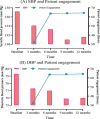Impact of Patient Engagement on Blood Pressure Control Among Older Individuals With Hypertension in a Mobile Health Intervention: Longitudinal Analysis Using Latent Growth Curve Modeling
- PMID: 40743531
- PMCID: PMC12313159
- DOI: 10.2196/71668
Impact of Patient Engagement on Blood Pressure Control Among Older Individuals With Hypertension in a Mobile Health Intervention: Longitudinal Analysis Using Latent Growth Curve Modeling
Abstract
Background: Limited research has investigated the influence of patient engagement on the long-term effects of mobile health (mHealth) interventions, particularly among older adults.
Objective: This study aimed to examine the long-term impact of a social media-driven mHealth intervention on blood pressure control among older Chinese individuals with hypertension, through repeated measurements of patient engagement and outcomes at 5 preset time points.
Methods: The study included older Chinese individuals with hypertension between 2017 and 2022. Participants received a hypertension self-management program via the WeChat social media app (Tencent Holdings Ltd), which provided clinically based digital coaching. Blood pressure measurements were taken repeatedly using a home blood pressure monitor (HBPM) connected to the app at baseline, 3, 6, 9, and 12 months. Patient engagement was evaluated based on the frequency of completed measurements at corresponding follow-ups. Latent growth curve models (LGCMs) served to assess the impact of patient engagement on blood pressure among older individuals with hypertension across preset points.
Results: A total of 1723 patients completed the 12-month follow-up (average age 70.1, SD 6.8 years; 890/1723, 51.7% female; and baseline systolic blood pressure 137.2 mm Hg). LGCMs revealed systolic blood pressure decreased significantly over 1 year, notably at 9 months (131 mm Hg, β9=3.244, P<.001), and continued up to 12 months (131.6mm Hg, β12=2.827, P<.001). In addition, a higher frequency of completed measurements was associated with better systolic blood pressure control at 3, 6, 9, and 12 months (β3=-0.016, P=.002; β6=-0.006, P=.02; β9=-0.002, P=.44; β12=-0.003, P=.02). These results remained significant even after accounting for age, sex, and comorbidity status.
Conclusions: This study, using LGCMs and repeated measures data, revealed a significant positive impact of patient engagement on long-term blood pressure control in mHealth interventions targeting older individuals with hypertension. These findings stress the importance of integration of patient-centered engagement approach into mHealth programs designed for chronic disease management in aging populations.
Keywords: aging population; hypertension; latent growth curve model; mHealth; mobile health; patient engagement.
© Nanxiang Zhang, Hai Lin, Xichun Wu, Yongjun Zheng, Jianan Yin, Chonglong Ding, Qi Pan, Shuo Yang, Hao Luo, Xinyan Zou, Yingfeng Ge, Jinxin Zhang. Originally published in the Journal of Medical Internet Research (https://www.jmir.org).
Conflict of interest statement
Figures




Similar articles
-
Exploring engagement patterns within a mobile health intervention for women at risk of gestational diabetes.Womens Health (Lond). 2025 Jan-Dec;21:17455057251327510. doi: 10.1177/17455057251327510. Epub 2025 Jun 5. Womens Health (Lond). 2025. PMID: 40470610 Free PMC article. Clinical Trial.
-
Computer and mobile technology interventions for self-management in chronic obstructive pulmonary disease.Cochrane Database Syst Rev. 2017 May 23;5(5):CD011425. doi: 10.1002/14651858.CD011425.pub2. Cochrane Database Syst Rev. 2017. PMID: 28535331 Free PMC article.
-
Association of Wearable Device-Measured Step Volume and Variability With Blood Pressure in Older Chinese Adults: Mobile-Based Longitudinal Observational Study.J Med Internet Res. 2024 Aug 14;26:e50075. doi: 10.2196/50075. J Med Internet Res. 2024. PMID: 39141900 Free PMC article.
-
mHealth Interventions for Self-management of Hypertension: Framework and Systematic Review on Engagement, Interactivity, and Tailoring.JMIR Mhealth Uhealth. 2022 Mar 2;10(3):e29415. doi: 10.2196/29415. JMIR Mhealth Uhealth. 2022. PMID: 35234655 Free PMC article.
-
Impact of 12-Month mHealth Home Telemonitoring on Clinical Outcomes in Older Individuals With Hypertension and Type 2 Diabetes: Multicenter Randomized Controlled Trial.JMIR Mhealth Uhealth. 2025 May 29;13:e59733. doi: 10.2196/59733. JMIR Mhealth Uhealth. 2025. PMID: 40440692 Free PMC article. Clinical Trial.
References
-
- Abdisa L, Balis B, Shiferaw K, et al. Self-care practices and associated factors among hypertension patients in public hospitals in Harari regional state and Dire Dawa City administration, Eastern Ethiopia: a multi-center cross-sectional study. Front Public Health. 2022;10:911593. doi: 10.3389/fpubh.2022.911593. doi. Medline. - DOI - PMC - PubMed
-
- Whelton PK, Carey RM, Aronow WS, et al. 2017 ACC/AHA/AAPA/ABC/ACPM/AGS/APhA/ASH/ASPC/NMA/PCNA Guideline for the Prevention, Detection, Evaluation, and Management of High Blood Pressure in Adults: a report of the American College of Cardiology/American Heart Association Task Force on Clinical Practice Guidelines. Hypertension. 2018 Jun;71(6):e13–e115. doi: 10.1161/HYP.0000000000000065. doi. Medline. - DOI - PubMed
MeSH terms
LinkOut - more resources
Full Text Sources
Medical

